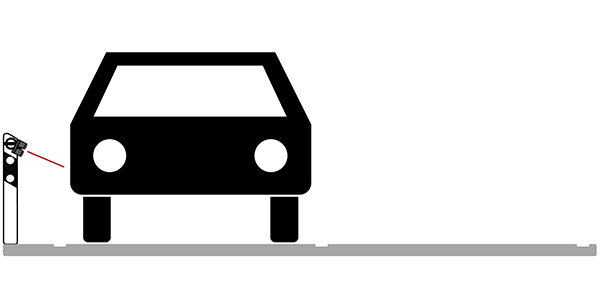Correlations in Spatiotemporal Headway Dynamics of Road Traffic Using Extremely Accurate Microscopic Empirical Data
DOI:
https://doi.org/10.17815/CD.2020.81Keywords:
sensor system, road traffic, urban traffic, headway development, empirical headway distribution, empirical speed distribution, correlations in headway dynamics, connected and automated vehicle (CAV), single lane driving, vehicle mergingAbstract
As we recently showed by using empirical data there is a certain behavior referring to the development of the headway between two consecutive human driven vehicles. Following on from this, we investigate correlations of the change in temporal headway over two subsequent road segments as the main goal of the present work and found a strongly correlated behaviour for increasing temporal headways. In this way a strong improvement for short-term prediction algorithms of conventional road users should be achieved. A stationary infrared-based sensor system was developed for this purpose, which has been mounted at reflector posts next to an urban street over a distance of about 50m. Due to its good accuracy, we are able to resolve vehicle following times down to 25 milliseconds and to determine speeds more precisely. In 45 hours of measurement the system detected over 20,000 passing vehicles.References
Kumm, M., Schreckenberg, M.: Statistical analysis of temporal headway development through empirical data in urban traffic. In: 2019 6th International Conference on Models and Technologies for Intelligent Transportation Systems (MT-ITS), pp. 1-9. IEEE (2019)
González, D., Pérez, J., Milanés, V., Nashashibi, F.: A review of motion planning techniques for automated vehicles. IEEE Trans. ITS 17(4), 1135-1145 (2016)
Wadud, Z., MacKenzie, D., Leiby, P.: Help or hindrance? the travel, energy and carbon impacts of highly automated vehicles. Transportation Research Part A: Policy and Practice 86, 1-18 (2016)
Wang, C.X., Cheng, X., Laurenson, D.I.: Vehicle-to-vehicle channel modeling and measurements: recent advances and future challenges. IEEE Communications Magazine 47(11) (2009)
Milanes, V., Villagra, J., Godoy, J., Simo, J., Rastelli, J.P., Onieva, E.: An intelligent v2i-based traffic management system. IEEE Transactions on ITS 13(1), 49-58 (2012)
Wagner, P.: Traffic control and traffic management in a transportation system with autonomous vehicles. In: Autonomous Driving, pp. 301-316. Springer (2016)
Bischoff, J., Maciejewski, M.: Simulation of city-wide replacement of private cars with autonomous taxis in berlin (2016)
Friedrich, B.: Verkehrliche wirkung autonomer fahrzeuge. In: Autonomes Fahren, pp. 331-350. Springer (2015)
Vranken, T., Sliwa, B., Wietfeld, C., Schreckenberg, M.: Performance comparison of dynamic vehicle routing methods for minimizing the global dwell time in upcoming smart cities. In: 88th IEEE Vehicular Technology Conference (VTC-Fall), 2018. IEEE (2018)
Lefèvre, S., Vasquez, D., Laugier, C.: A survey on motion prediction and risk assessment for intelligent vehicles. ROBOMECH journal 1(1), 1 (2014)
Glaser, S., Vanholme, B., Mammar, S., Gruyer, D., Nouveliere, L.: Maneuver-based trajectory planning for highly autonomous vehicles on real road with traffic and driver interaction. IEEE Transactions on intelligent transportation systems 11(3), 589-606 (2010)
Elbanhawi, M., Simic, M.: Sampling-based robot motion planning: A review. IEEE access 2, 56-77 (2014)
Krbálek, M., Šleis, J.: Vehicular headways on signalized intersections: theory, models, and reality. Journal of Physics A: Mathematical and Theoretical 48(1), 015101 (2014)
Cowan, R.J.: Useful headway models. Transportation Research 9(6), 371-375 (1975)
Yuan, J., Mills, K.: A cross-correlation-based method for spatial-temporal traffic analysis. Performance evaluation 61(2-3), 163-180 (2005)
Pan, T., Sumalee, A., Zhong, R.X., Indra-Payoong, N.: Short-term traffic state prediction based on temporal-spatial correlation. IEEE Transactions on Intelligent Transportation Systems 14(3), 1242-1254 (2013)
Nagel, K., Schreckenberg, M.: A cellular automaton model for freeway traffic. Journal de physique I 2(12), 2221-2229 (1992)
Chandler, R.E., Herman, R., Montroll, E.W.: Traffic dynamics: studies in car following. Operations research 6(2), 165-184 (1958)
Ossen, S., Hoogendoorn, S.P., Gorte, B.G.: Interdriver differences in car-following: A vehicle trajectory-based study. Transportation Research Record 1965(1), 121-129 (2006)
Monteil, J., OHara, N., Cahill, V., Bouroche, M.: Real-time estimation of drivers' behaviour. In: 2015 IEEE 18th International Conference on Intelligent Transportation Systems, pp. 2046-2052. IEEE (2015)
Galton, F.: I. co-relations and their measurement, chiefly from anthropometric data. Proceedings of the Royal Society of London 45(273-279), 135-145 (1889)
Fahrmeir, L., Heumann, C., Künstler, R., Pigeot, I., Tutz, G.: Statistik: Der Weg zur Datenanalyse. Springer-Verlag (2016)
Kerner, B.S.: Breakdown in traffic networks: fundamentals of transportation science. Springer (2017)

Downloads
Published
How to Cite
Issue
Section
License
Copyright (c) 2020 Maximilian Kumm, Michael Schreckenberg

This work is licensed under a Creative Commons Attribution 4.0 International License.
Authors contributing to Collective Dynamics agree to publish their articles under the Creative Commons Attribution 4.0 license.
This license allows:
Share — copy and redistribute the material in any medium or format
Adapt — remix, transform, and build upon the material
for any purpose, even commercially.
The licensor cannot revoke these freedoms as long as you follow the license terms.
Authors retain copyright of their work. They are permitted and encouraged to post items submitted to Collective Dynamics on personal or institutional websites and repositories, prior to and after publication (while providing the bibliographic details of that publication).








